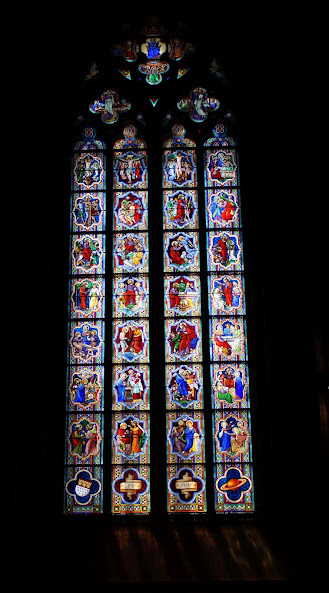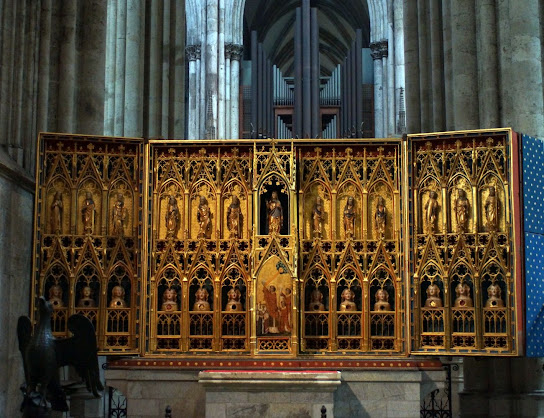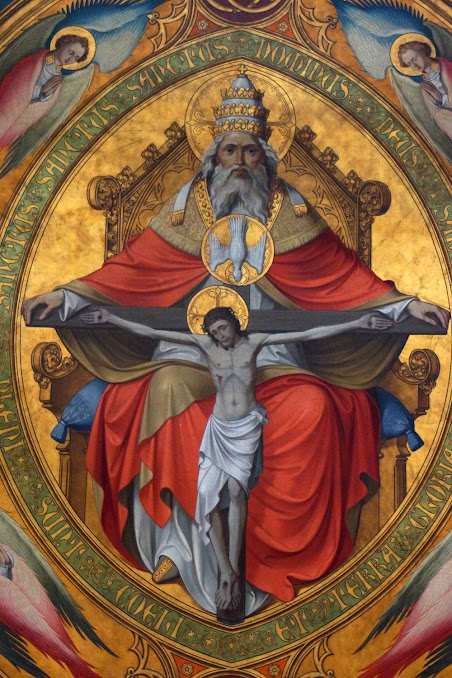A few days ago I had the chance to visit the worldfamous and cultural world heritage in the city of Cologne: the "Dom von Köln".
The relics of The Three Kings are worshipped in a massive golden shrine inside the cathedral.
The Dome
407.000 cubic meters of enclosed space
wheight of the dome = 300.000 tons!
length: 144,58 m
width (total): 86,25 m
facade (west) 61,54 m
height of the southern tower 157,22 m
height of the northern tower 157,18 m
height of the spine 109,12 m
roof 12.000 square metres
456 doors
12 bells
wheight St. Peter's bell: 24 t (clapper: 700kg)
On 6 January 2011, the clapper broke and dropped on the floor below. The
four earthquake sensors in the cathedral registered it. As it could not
be repaired, a new one was cast and was installed in December of the
same year
800 places to sit down and pray + additional 1500 places if needed
seismographs to monitor earthquakes: 4
from the cathedral to the main train station: 3 minutes to walk
6 million visitors each year
2 of them were us on the 18th June 2023

Before we could step inside the dome, the holy mass had to end. I would have attended the holy mass, but I was too late. Nevertheless we were allowed to enter quickly (it was getting hot at noon) and could take a first glimpse. Here you can see the typical cross vaults
After a short while the wardens in their red and black vestures opened the gate and we wandered through the nave and aisles.
the Epaulette- or Nave-Organ
If you want to know more specific information, please check
this wiki-page The "Jesus of Nazareth"-window dated 1884 and restored 2005.
The cathedral has a total of around 10,000 m² of window area, of which around 1,500 m² comes from the Middle Ages.
The more than four meter high oil painting depicting the Assumption of Mary was completed by the late Nazarene painter Friedrich Overbeck on behalf of the Düsseldorf Art Association in 1855.
Above the empty tomb of Mary the Blessed Mother levitates in the mandorla, framed by eight angels. The inclusion of the progenitors and prophets, kings and women of the Old Testament in the central zone of the picture is atypical for depicting the Assumption of Mary.
The Agilolphus altar, which used to be the main altar in the Gothic east choir of the Cologne collegiate church of St. Maria ad gradus and is one of the largest and most important carved altars in Antwerp, probably came to the cathedral in 1817. It was created around 1520 and originally consisted of a carved central shrine with two pairs of painted wings, a carved base with its own pair of painted wings and three corbeled crowning sculptures. There is an opening in the center of the base that was used to store the Agilolphus shrine. With the wings closed, the altar displayed a large-scale Annunciation flanked by four bishops, while four scenes from the Passion of Christ were visible in the base.
The Cologne Artist Bartholomäus Bruyn the Elder painted this small winged altar in cool colors in 1548. The central panel shows the crucifixion of Christ with the mourners Mary and John and Mary Magdalene behind the cross. The agitated landscape in the background of the Crucifixion continues on the side wings, on which two kneeling donors in canon costume of St. Andreas (left) and Peter (right) are recommended.
The monumental wooden cross (2 metres tall!) was donated by Archbishop Gero (976). It stood in the old cathedral in the middle of the church by Gero's grave. In the new cathedral, it was placed above the altar of the Stephanus chapel around 1270 and moved to its current location on the east wall of the Kreuzkapelle around 1350.
The crucifix and the crossbeam are original, the radiant sun behind the cross and the marble altar were created in 1683 as a donation by the canon Heinrich Mering.
It is not only the first surviving monumental sculpture after antiquity, but also the earliest reproduction of the dead Christ on the cross on a monumental scale. The high artistic and technical quality of such an early masterpiece can hardly be explained.
The Klarenaltar or Clarenaltar, created around 1350/60, was originally located in the Franciscan Church of St. Clara in Cologne and after its secularization and demolition came to the cathedral.
The altar is a six meter wide Gothic winged altar. Today it is considered an "altar of superlatives."
The
neo-Gothic artist Friedrich Wilhelm Mengelberg was commissioned to
design the back in 1905, creating one of the most recent neo-Gothic
works in the cathedral. The painting shows the divine Trinity in an almond-shaped frame.
The colored figure of St. Christophorus was made of tuff stone. Christophorus was created around 1470 by Tilman van der Burch, the leading late Gothic sculptor in the Cologne area. The saint stands on a console with angels bearing coats of arms, whose donor is no longer known. He walks through a river with his robe gathered up, carrying the Christ Child with the globe on his back. The heavy burden of the world, which he carries, can be clearly read from the 3.73 meter tall figure.
The carved figure of St. Ursula found its way into the cathedral in 1893 from the collection of Frankfurter citizen Ernst Münzenberger. Standing over a console, the saint holds an arrow in her left hand that symbolizes her martyrdom. She stretches out her right hand protectively over a group of ten virgins who have found shelter under her wide cloak.
A pediment crowned with the Star of Bethlehem rises above the column-decorated main floor. The flanking alabaster statues of St. Felix and Nabor were added in 1699 by Michiel van der Voort from Antwerp. In front of the lattice in the middle of the display wall, behind which the shrine of the Three Kings was visible in the treasury until 1948, the Madonna of Jewels has been placed inside in 1963.
Altar of the city patrons The winged altar painted by the Cologne painter Stefan Lochner († 1451) for the council chapel of the city of Cologne around 1442 is the most important work of the late Gothic Cologne school of painting.
After it had been hidden from the French revolutionary troops in 1794 and after the profanation of the council chapel in 1810, the altar was transsferred to the cathedral - on behalf of the Cologne art collector F.F. Wallraff. Today it forms the center of the Marienkapelle, whose altar it decorates. It is still in daily use for holy masses.
Just two tiny details of the magnificent mosaic, that covers an area of 1,350 square meters. It is on the floor in the crossing, inner choir and ambulatory and it is without a doubt the largest work of art in terms of area in Cologne Cathedral.
The Shrine of the Three Kings is the largest, artistically most important and contentwise most demanding reliquary of the Middle Ages.
The shrine is 1,10 m wide, 1,53 m high, 2,20 m long and weighs 500 kg.
It consists of a renewed oak core (the original structure is in the cathedral treasury), gold, gilded silver and copper. The walls stand on a double floor slab and are surrounded by coupled enamel columns on a brown varnish background.
The relics of the kings were transferred to Cologne from Milan in 1164. The shrine was created from around 1190 to around 1220 by the workshop of the goldsmith Nikolaus von Verdun and subsequent workshops in Cologne and the Maasland.The artistic adornment consists of fire-gilded figures embossed in gold and silver, filigree plates set with stones (precious stones, semi-precious stones, antique cut gems and cameos) and enamel on columns, arches and profiles.
In medieval times it was planned to set up the shrine in the crossing of the cathedral. Today it rises behind the medieval high altar and thus forms the center of the Gothic cathedral, which was built for him as a stone reliquary.
There is no reliable information about the origin of the relics of the Three Kings and their veneration.
That's where Helena comes in
An icon of St. Constantine and Helena
(not related to the cathedral)
©Aperges
Flavia Julia Helena (
*AD 246/248 +330), also known as Helena of Constantinople and Saint Helena, was an
Augusta (Empress) of the Roman Empire and mother of Emperor Constantine the Great. The Eastern Orthodox Church, Catholic Church, Oriental Orthodox
Churches, and Anglican Communion revere her as a saint, and the Lutheran
Church commemorates her.
In her final years, she made a religious tour of Syria,
Palaestina and Jerusalem, during which she discovered the True Cross. According to tradition, Helena ordered a temple to be torned down and chose a
site to begin excavating, which led to the recovery of three different
crosses. She had a woman who was near death, brought from the city. When the
woman touched the first and second crosses, her condition did not
change, but when she touched the third and final cross she suddenly
recovered.
Sozomen and Theodoret claim that Helena also found the nails of the crucifixion.
To use their miraculous power to aid her son, Helena allegedly had one
placed in Constantine's helmet, and another in the bridle of his horse.
According to one tradition, Helena acquired the Holy Tunic on her trip to Jerusalem and sent it to Trier.
Let's go outside again





































.jpg)



No comments:
Post a Comment